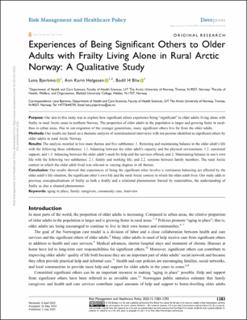| dc.contributor.author | Bjerkmo, Lena Yvonne | |
| dc.contributor.author | Helgesen, Ann Karin | |
| dc.contributor.author | Blix, Bodil Hansen | |
| dc.date.accessioned | 2022-10-20T10:56:40Z | |
| dc.date.available | 2022-10-20T10:56:40Z | |
| dc.date.created | 2022-06-30T15:53:08Z | |
| dc.date.issued | 2022 | |
| dc.identifier.citation | Risk Mangement and Healthcare Policy. 2022, 15, 1283—1292. | en_US |
| dc.identifier.issn | 1179-1594 | |
| dc.identifier.uri | https://hdl.handle.net/11250/3027281 | |
| dc.description.abstract | Purpose: Our aim in this study was to explore how significant others experience being “significant” to older adults living alone with frailty in rural Arctic areas in northern Norway. The proportion of older adults in the population is larger and growing faster in rural- than in urban areas. Due to out-migration of the younger generations, many significant others live far from the older adults. Methods: Our results are based on a thematic analysis of semistructured interviews with ten persons identified as significant others by older adults in rural Arctic Norway. Results: The analysis resulted in two main themes and five subthemes: 1. Restoring and maintaining balance in the older adult’s life with the following three subthemes: 1.1. balancing between the older adult’s capacity and the physical environment; 1.2. emotional support; and 1.3. balancing between the older adult’s need for help and the services offered; and 2. Maintaining balance in one’s own life with the following two subthemes: 2.1. family and working life; and 2.2. tensions between family members. The rural Arctic context in which the older adult lived was relevant to varying degrees in all themes. Conclusion: Our results showed that experiences of being the significant other involve a continuous balancing act affected by the older adult’s life situation, the significant other’s own life and the rural Arctic context in which the older adult lives. Our study adds to previous conceptualizations of frailty as both a bodily and a relational phenomenon framed by materialities, the understanding of frailty as also a situated phenomenon. | en_US |
| dc.language.iso | eng | en_US |
| dc.publisher | Dove Medical Press Ltd. | en_US |
| dc.relation.uri | https://www.dovepress.com/articles.php?article_id=76282 | |
| dc.rights | Navngivelse-Ikkekommersiell 4.0 Internasjonal | * |
| dc.rights.uri | http://creativecommons.org/licenses/by-nc/4.0/deed.no | * |
| dc.subject | aging in place | en_US |
| dc.subject | family caregivers | en_US |
| dc.subject | community care | en_US |
| dc.subject | interview | en_US |
| dc.title | Experiences of Being Significant Others to Older Adults with Frailty Living Alone in Rural Arctic Norway: A Qualitative Study | en_US |
| dc.type | Peer reviewed | en_US |
| dc.type | Journal article | en_US |
| dc.description.version | publishedVersion | en_US |
| dc.rights.holder | © 2022 Bjerkmo et al. | en_US |
| dc.subject.nsi | VDP::Samfunnsvitenskap: 200 | en_US |
| dc.source.pagenumber | 1283—1292 | en_US |
| dc.source.volume | 15 | en_US |
| dc.source.journal | Risk Mangement and Healthcare Policy | en_US |
| dc.identifier.doi | 10.2147/RMHP.S367079 | |
| dc.identifier.cristin | 2036424 | |
| cristin.ispublished | true | |
| cristin.fulltext | preprint | |
| cristin.qualitycode | 1 | |

